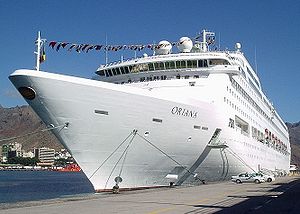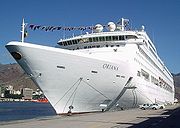MV Oriana (1995)
 Oriana in Gran Canaria, 2003 | |
| Career | |
|---|---|
| Name: | Oriana |
| Namesake: | SS Oriana (1959) |
| Owner: |
P&O, 1995-2000 P&O Princess Cruises PLC, 2000-2003 Carnival UK, 2003- |
| Operator: | P&O Cruises |
| Port of registry: |
1995—2006: London, 2006—present: Hamilton, 22x20px Bermuda[1] |
| Builder: | Meyer Werft, Papenburg, Germany |
| Yard number: | 636[2] |
| Launched: | 30 June 1994[2] |
| Christened: |
6 April 1995 by Queen Elizabeth II[2] |
| Acquired: | 2 April 1995[2] |
| Maiden voyage: | 9 April 1995[2] |
| In service: | 9 April 1995[2] |
| Identification: | IMO number: 9050137 |
| Status: | In service |
| General characteristics [2] | |
| Class and type: | Cruise ship |
| Tonnage: | 69,153 gross register tons (GRT) |
| Displacement: | 6,715 metric tons deadweight (DWT) |
| Length: | 260.00 m (853.02 ft) |
| Beam: | 32.20 m (105.64 ft) |
| Draught: | 7.90 m (25.92 ft) |
| Decks: | 10 (passenger accesible)[3] |
| Installed power: |
2 × MAN-B&W 6L58/64 diesels 2 × MAN-B&W 9L58/64 diesels combined 47750 kW |
| Speed: | Trials: 26.2 knots (48.52 km/h, 30.15 MPH)<br\> Service: 24 knots (44 km/h, 29 MPH) |
| Capacity: |
1822 (normal) 1928 (maximum)[3] |
| Crew: | 794[3] |
MV Oriana is a cruise ship of the P&O Cruises fleet. The ship was built by Meyer Werft at their shipyard in Papenburg, Germany. At 69,000 tonnes, Oriana is the sixth largest of seven ships currently in service with P&O Cruises. She is also the sister ship of MV Aurora. She officially entered service with the company in April 1995 and was named by HM Queen Elizabeth II.[4] Oriana holds the Golden Cockerel, as the fastest ship in the P&O Cruises fleet.
Contents
Overview
When she was built in 1995, Oriana was the first new ship commissioned for P&O Cruises, and the first to be designed specifically for the British cruise market. She is the longest serving ship in the fleet, having been in continuous service with the company since she was launched. [5] She is the second ship to carry the name Oriana, and is named in tribute to the SS Oriana, which served for Orient Line and P&O from 1959 until 1986. After a lengthy campaign, P&O Cruises were permitted to allocate the new Oriana with the call sign 'GVSN', which is the same call sign as the former SS Oriana.[6]
From 1995 when she was built, until 2000, Oriana was owned by the Peninsular & Oriental Steam Navigation Company. In 2000, P&O de-merged it's cruise ship operations, with ownership of Oriana transferring to the new company, P&O Princess Cruises PLC. In 2003, P&O Princess merged with Carnival Corporation and Oriana came under the ownership of Carnival UK. Despite these changes of ownership, Oriana has been operated by P&O Cruises throughout.
In 2006, she was re-registered to Bermuda so that weddings could be conducted on board, and as a result, her call sign was changed to ZCDU9.
Statistics
Oriana is 260 metres (853 ft) long, with a beam of just over 32 metres (105 ft), and a draught of 7.9 metres (26 ft), which varies up to 8.2 m depending on load. She has a gross tonnage (GT) of 69,153 tons and a maximum passenger capacity of 1,928. Outside passenger deck space is 105,000 sq feet. Power is provided by four MAN B&W Diesels generating a total of 47,750 kW giving her a service speed of 24 knots (44 km/h).
Design and construction
P&O had wanted the new Oriana to have been built in the United Kingdom, but unfortunately there were no British shipyards left capable of completing such an order so P&O Cruises were forced to look overseas.[7]
One of her main designers, Robert Tillberg, spent a lot of the time on board SS Canberra investigating the needs of British passengers and including as many features of Canberra possible into Oriana's design. The Oriana's single funnel is designed to have a resemblance to Canberra's twin funnels. She has a single deck of balconies reserved for suites, mini suites and staterooms to cater for the growing desire for balconies on board.
Service history
When she entered service Oriana was one of the largest cruise ships in the world, and also the largest ship built in Germany since 1914. Since then tonnages have boomed as the economies of scale dictate that a larger ship generates more profit. Nowadays most new cruise ships have a GRT of around 100,000 tonnes. Annually undertaking World cruises with fleetmate Aurora, she normally operates cruises within the Mediterranean, the Canaries and the Baltic seas.
In December 2006 the Oriana underwent a £12 million refit in Bremerhaven, Germany. Coinciding with the refit she was re-registered from Britain to Bermuda[1] in order to enable Weddings at Sea to take place on board. Due to the success of the 'Arcadian Rhodes' restaurant on board the Arcadia, a new Oriana Rhodes restaurant was introduced, replacing The Curzon Room. Oriana Rhodes was designed by celebrity chef Gary Rhodes and can accommodate 96 passengers. Other modifications included the extension of the popular Lords Tavern bar, festooned with cricket memorabilia and refurbishment of the children's play areas. In addition all of her cabins were restyled to include one of four new colour schemes, new curtains, carpets, beds, linen and duvets.
Golden Cockerel
MV Oriana holds the Golden Cockerel trophy for the fastest ship in the P&O fleet. Previously held by SS Oriana it passed to SS Canberra on retirement of the first Oriana in 1986. On Canberra's final cruise in 1997 the Golden Cockerel was handed over to the new Oriana when both ships were anchored off Cannes and sent boats out to perform the handover.
References
- ↑ 1.0 1.1 "Shipping News 2006". Maritime Matters. 2008-11-23. http://www.maritimematters.com/shipnews2006e.html. Retrieved 2008-03-19.
- ↑ 2.0 2.1 2.2 2.3 2.4 2.5 2.6 (Swedish) Micke Asklander. "M/S Oriana (1995)". Fakta om Fartyg. http://www.faktaomfartyg.se/oriana_1995.htm. Retrieved 2007-12-17.
- ↑ 3.0 3.1 3.2 "Oriana ship statistics". P&O Cruises official website. http://www.pocruises.com/pocruising/learnmore-oriana-ship-statistics.aspx. Retrieved 2007-12-17.
- ↑ http://www.pocruises.com/Cruise-Ships/Oriana/Ship-Webcams/
- ↑ http://www.poships.co.uk/Oriana%201995%20History.html
- ↑ Call sign SS Oriana.
- ↑ Johnman, Lewis; Murphy, Hugh (2002). British Shipbuilding and the State since 1918: a political economy of decline. Ithaca: Regatta Press. ISBN 0967482666.
External links
| MV Oriana (1995)
]]
| ||||||||||||||||


